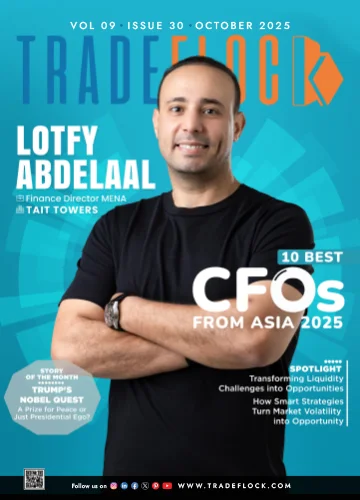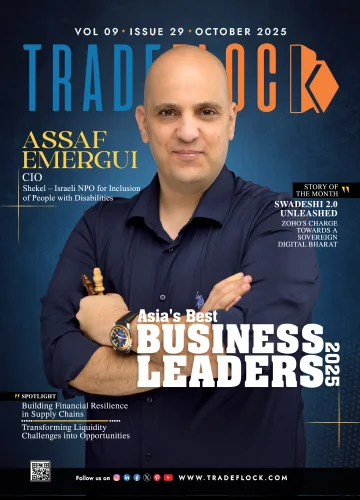
Leading with Clarity, Strategy, and Purpose
Ali Ahmed
Director Of Technology


Leading with Clarity, Strategy, and Purpose
Ali Ahmed
Director Of Technology,
Adroit Information Solutions
When the Australian company Adroit Information Solutions decided to establish an offshore unit in India, their aim was cost efficiency and operational support. What they gained was a transformational leader in Ali Ahmed— someone who would not only set up the India operations but also redefine the company’s growth trajectory. Joining as Director of Technology, Ali quickly took charge of building the offshore arm, hiring talent, optimising back-office functions, and implementing strong IT systems. However, his vision extended far beyond operational efficiency. Recognising the untapped potential in global markets, Ali spearheaded the company’s expansion, growing its presence from Australia to 14 countries across the Middle East, North Africa and the United States. With his deep understanding of technology and its business applications, Ali became a driving force behind Adroit’s international growth. Today, he plays a key role in shaping strategic direction, overseeing execution, and driving results through cross-functional leadership, all while remaining committed to delivering value and driving transformation. He discusses more about his work and strategies here with TradeFlock.
What’s one risky decision early in your career that turned out to be transformational?
Back in 2009, I made a career move that raised a few eyebrows — and ultimately changed everything for me. I was leading IT projects at a major wealth management and investment banking firm that had just been acquired by a global powerhouse. On paper, I had it made: a prestigious offer from a top hedge fund and multiple leadership roles within the acquiring company. Most would’ve picked the safe bet. I didn’t. Instead, I took a chance on a bold, unproven path — joining a management buyout (MBO) venture as Vice President of IT. We were a lean team of just 180 people, stepping out on our own in a highly competitive space. It felt like a leap into the unknown, but it turned out to be the most rewarding decision of my career. In that high-growth, high-stakes environment, I had the opportunity to wear multiple hats — shaping tech strategy, building systems from the ground up, and working side by side with business leaders. It gave me exposure that a structured corporate role simply couldn’t offer at that pace. More importantly, it taught me resilience, agility, and how to lead through uncertainty — lessons that continue to guide me in every leadership role I’ve taken since.
What core value anchors your leadership decisions, balancing strategic vision with tactical precision?
One core value that anchors my leadership decisions is putting “Human First”. No matter how ambitious the strategy or how precise the execution, I believe true success starts with people. Every decision I make — whether it involves change, challenge, or opportunity — is guided by empathy, fairness, and the belief that empowered individuals drive
One core value that anchors my leadership decisions is putting "Human First". No matter how ambitious the strategy or how precise the execution, I believe true success starts with people.
meaningful progress. When people feel seen, heard, and supported, performance follows naturally, innovation becomes organic, and organisations thrive.
How do you align and communicate effectively between business and technology teams?
Operating at the crossroads of business and technology, I see both as tools for one mission: solving real-world problems. Whether deploying innovative tech solutions or driving strategic initiatives, the goal is always to create value. That’s why I prioritise clarity over complexity — bridging objectives, not just translating terminology. I start by understanding the “why” behind a business need. Once that’s clear, I shape and communicate technical solutions aligned with outcomes — efficiency, customer experience, or profitability. I challenge tech teams to connect their work to broader business goals. Alignment is key, so I foster it through regular check-ins, joint KPIs, and cross-functional workshops. I also adapt my approach when collaborating with Millennials, Gen Z, and Gen Alpha, tapping into their unique problemsolving styles to ensure innovation thrives.
Can you share a tech failure and its lessons on leadership and resilience?
One memorable lesson in leadership and resilience came during a large-scale transformation project tied to an Offshore Business Initiative (OBI). We had spent months transitioning from a remote IT infrastructure to a fully localised setup — driven by the need for tighter control and compliance. It was a complex but rewarding process, involving stakeholder coordination, detailed planning, and successful execution. Just when we thought we had stabilised the new environment, an acquisition shifted the company’s strategic direction. Suddenly, all efforts had to be reversed — back to a remote infrastructure model. At first, it felt like all the hard work had been for nothing. But it quickly became clear: leadership isn’t just about getting the plan right — it’s about responding to change with calm, clarity, and conviction. That moment taught me that resilience is not clinging to past wins but embracing shifts with maturity. True leadership lies in guiding teams through change, sustaining morale, and transforming setbacks into stepping stones.
How do you unplug from tech, and what helps keep your creativity alive?
To unplug and recharge outside the tech world, I turn to meaningful conversations — often over a simple cup of coffee — with Millennials, Gen Z, and even emerging Gen Alpha professionals. These candid exchanges about life, trends, and their worldview spark my curiosity and keep my thinking fresh. It’s in these unstructured, real dialogues that I find new ideas, inspiration, and a creative reset.












